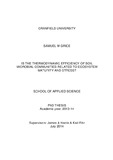JavaScript is disabled for your browser. Some features of this site may not work without it.
| dc.contributor.advisor | Harris, Jim | |
| dc.contributor.advisor | Ritz, K. | |
| dc.contributor.author | Grice, Samuel M. | |
| dc.date.accessioned | 2015-05-28T15:20:43Z | |
| dc.date.available | 2015-05-28T15:20:43Z | |
| dc.date.issued | 2014-07 | |
| dc.identifier.uri | http://dspace.lib.cranfield.ac.uk/handle/1826/9210 | |
| dc.description.abstract | According to the second law of thermodynamics, no process can be 100% efficient and all processes must increase the total entropy of the system they occupy. Therefore, living systems require a constant influx of low-entropy energy to survive, giving an evolutionary advantage to those that produce less waste. Odum suggested that ecosystems would therefore develop mechanisms for reducing entropy production per unit biomass, as they matured. Isothermal calorimetry allows the direct measurement of waste heat emitted from any system, including soils and the life within them. However, upon review it became apparent that current methods employed in the analysis of soil microbial communities via isothermal calorimetry are outdated and in need of review. An experiment was conducted to troubleshoot the method and appropriate modifications were made. A second experiment was conducted to test the microbial community response to pre-incubation prior to calorimetric analysis at 20°C, concluding that samples should be pre-incubated for ten to sixteen days prior to analysis at 20°C. Subsequently, experiments were carried out to establish how much waste heat was produced by soil microbial communities in the context of various ecological gradients, following glucose amendment. Results for enthalpy efficiency (ηeff) proved inconclusive, whereas results for substrate induced heat production (SIHP), where heat output is expressed per unit biomass, indicated that soil microbial communities produced significantly more waste heat when subjected to long-term metals induced stress and short-term copper-induced stress. In addition, a reduction in the production of waste heat generated by soil microbial communities associated with primary succession along a glacier foreland was observed. This provides evidence that living systems do indeed evolve towards greater thermodynamic efficiency, manifest via the reduction of energetic waste. | en_UK |
| dc.language.iso | en | en_UK |
| dc.publisher | Cranfield University | en_UK |
| dc.rights | © Cranfield University 2014. All rights reserved. No part of this document may be reproduced without the written permission of the copyright owner. | en_UK |
| dc.title | Is the thermodynamic efficiency of soil microbial communities related to ecosystem maturity and stress? | en_UK |
| dc.type | Thesis or dissertation | en_UK |
| dc.type.qualificationlevel | Doctoral | en_UK |
| dc.type.qualificationname | PhD | en_UK |
| dc.contributor.funder | National Environmental Research Council(NERC) | |
| dc.contributor.funder | The Swedish Research Council Formas |
